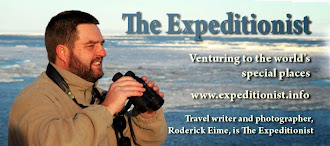G Adventures West Africa. Day 16 and 17: Ghana
pics: fish market on the shore in front of Cape Coast Castle, inside the
courtyard of Cape Coast Castle
Day 16 and 17: Ghana
Two ports in Ghana gave us valuable additional insight into one of the most
rapidly developing countries in the West African region. Like so many
relatively new nations along the former, so-called ‘slave coast’,
independence brought many new challenges. Unlike its Francophone neighbours,
English-speaking Ghana was a little easier to travel in and deal with the
rigours of market negotiations.
Our first stop at Port Tema, which is the access point to the capital,
Accra, was a lower key affair with simple visits to a glass bead factory and
the Shai Hills Wildlife reserve where our late morning arrival meant we
wouldn’t see many of the animals out and about. Semi-tame baboons and
ostriches greeted us at the gate before we drove through the park and
managed sightings of antelope and not much else. Our first day culminated in
a stop at a novelty coffin workshop where Ghanaians seem to have embraced
the fad of themed caskets for their final departure. Wooden cars, oversized
bottles, tools, fish and even a film projector were under construction
awaiting their clients’ final request.
The Accra craft and handicraft market sharpened negotiation skills as
enthusiastic hawkers descended on us like locusts with all manner of wares
and products. David Conrad demonstrated his years of skill and ethnographic
knowledge and emerged from the hurly-burly cradling a magnificent
century-old Benin bronze figurine acquired for a fraction of any Southeby
valuation. The rest of us made do with shirts, postcards and run-of-the-mill
wood carvings. Steve Boyes, our naturalist, sadly reported the discovery of
many illegal wildlife products like hyena hide belts and even a full jaguar
skin.
Day two exposed us to the sad history of slavery and colonial servitude in
the region of the vast Takoradi port. Here two massive, UNESCO World
Heritage-listed castles serve as a tragic reminder to the era when huge
numbers of slaves were shipped out to their final destinations. Many guests
emerged from the pitch black underground dungeons visibly moved, some even
reporting an eerie presence and faint supernatural mutterings in the empty
subterranean chambers.
While some of our party chose to venture out to Kakum National Park for the
famous forest canopy walk, I chose to hang back for a more in-depth look at
these solemn monuments.
The Cape Coast Castle and Elmina Castle are both surrounded by bustling
fishing villages, especially the latter where fleets of little vessels
venture out through the surf to fish. The vivid spectacle of traditional
wooden boats with colourful banners, surrounded by throngs of eager mongers
created a scene much like a medieval market or fête. Against the ominous
backdrop of the castles, the only modern giveaway was fishermen wearing
modern soccer jerseys and fluro flip-flops. Centuries ago, it would have
been a similar scenario, except that lines of forlorn and manacled Negroes
would be seen shuffling onto those same boats for transport to
God-only-knows-where.
For more detail on this itinerary, see www.gadventures.com > West Africa
More images at www.flickr.com/photos/rodeime
Sent to you over a satellite phone using GMN’s XGate software.
Please be kind and keep your replies short




You must be logged in to post a comment Login